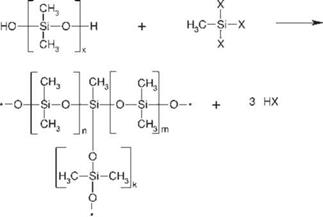One-Part Silicone Adhesives
One-part silicone adhesives are known as RTV-1 adhesives (RTV = room temperature vulcanizing). They contain a polyorgano-siloxane with terminal — OH groups, and a crosslinking agent (e. g. methyl triacetoxy silane) which is sensitive to hydrolysis — that is, it reacts with water. When the silicone is applied, the crosslinking agent reacts with
|
Figure 5.35 Reaction mechanism of a one-part silicone system. |
the ambient moisture to generate silanol, which in turn reacts with the free — OH groups of the base polymer, resulting in a crosslink. The reaction is shown schematically in Figure 5.35. When methyl triacetoxy silane is used as the crosslinker, acetic acid is liberated during the reaction; indeed, the odor of this is familiar to many consumers who use one-part silicones at home or at work.
In RTV-1 systems, ambient water initiates the reaction, the rate of which is a function of the humidity of the air, the temperature and the bond-line thickness. Full crosslinking is obtained (depending on these parameters) within a period of few hours to several days. The addition of substances such as NaOH or Ca(OH)2 enhances the crosslinking process. Indeed, products that are split off during condensation (e. g. acetic acid) are transformed into water by these substances. This water, in addition to that which penetrates by diffusion from the outside, enhances the curing process and prevents the development of acetic acid vapors.
 25 сентября, 2015
25 сентября, 2015  Pokraskin
Pokraskin 
 Опубликовано в рубрике
Опубликовано в рубрике 